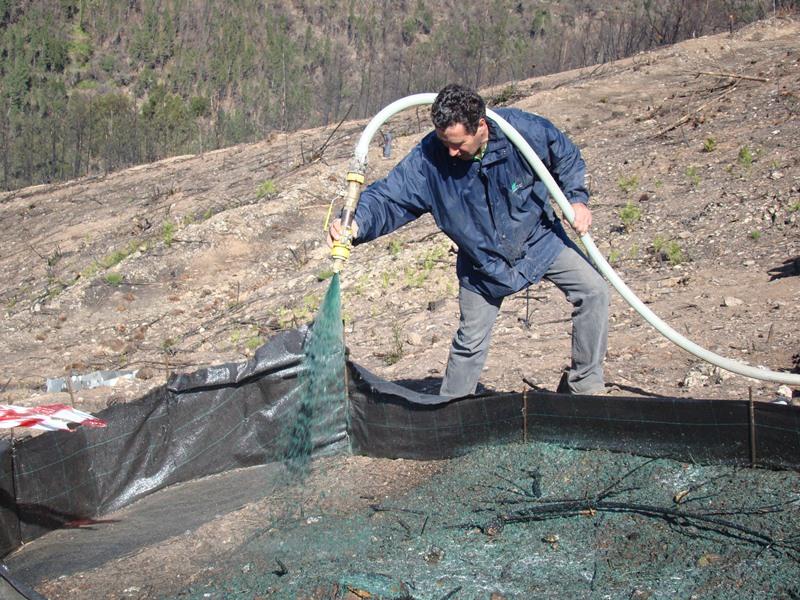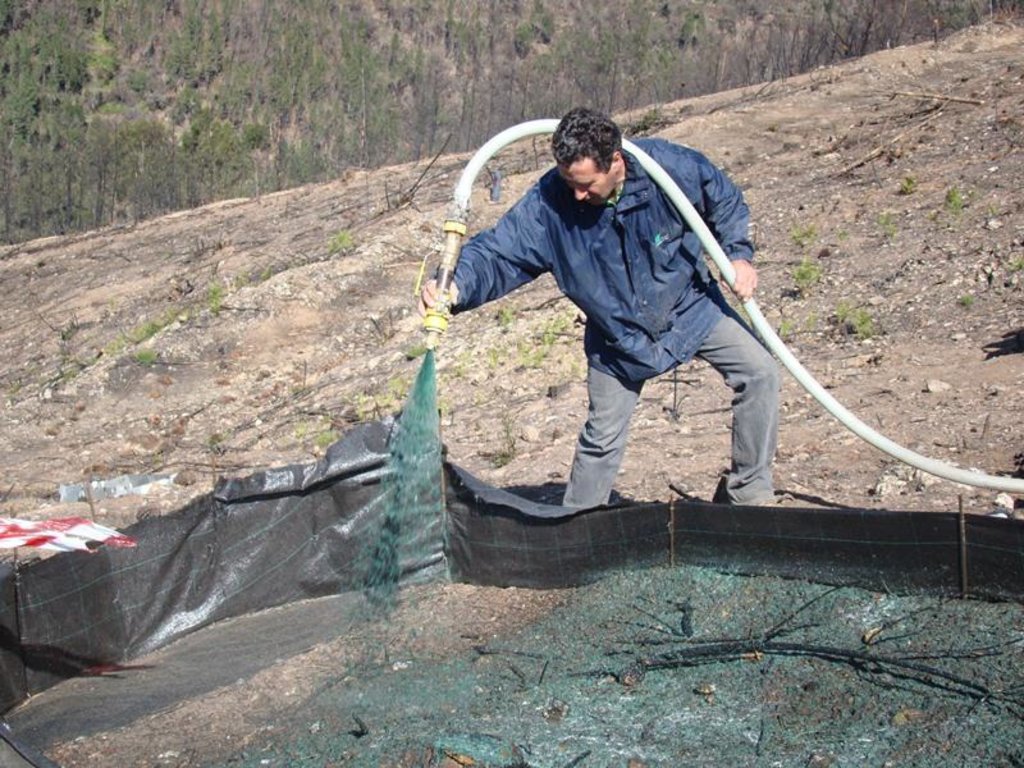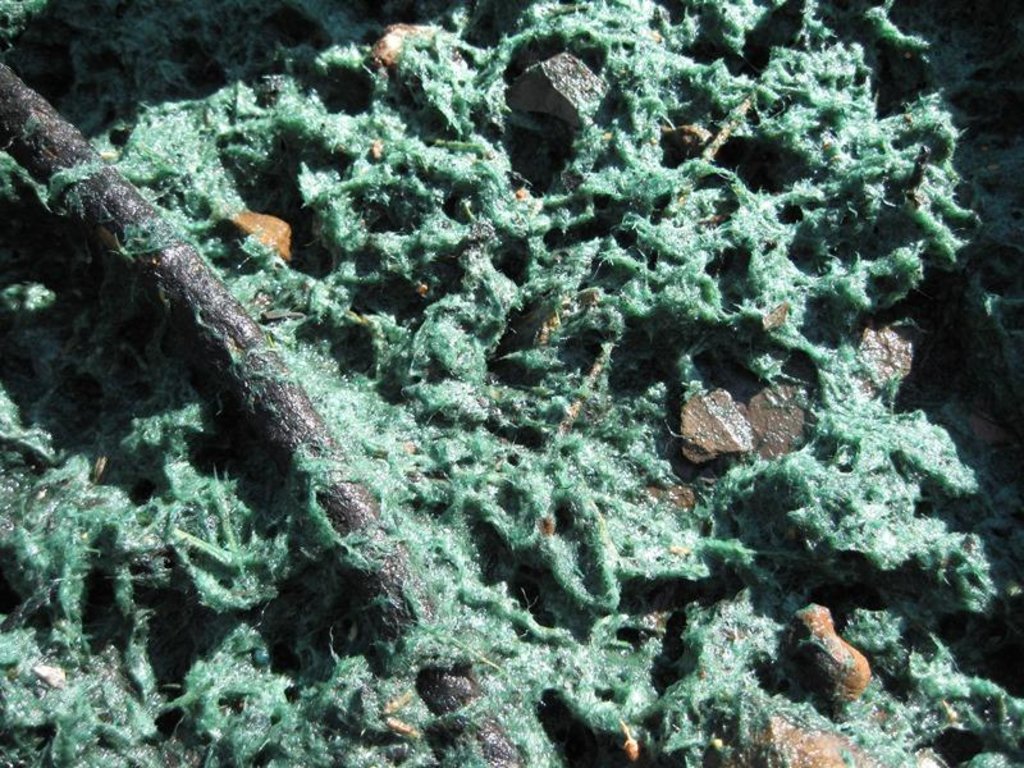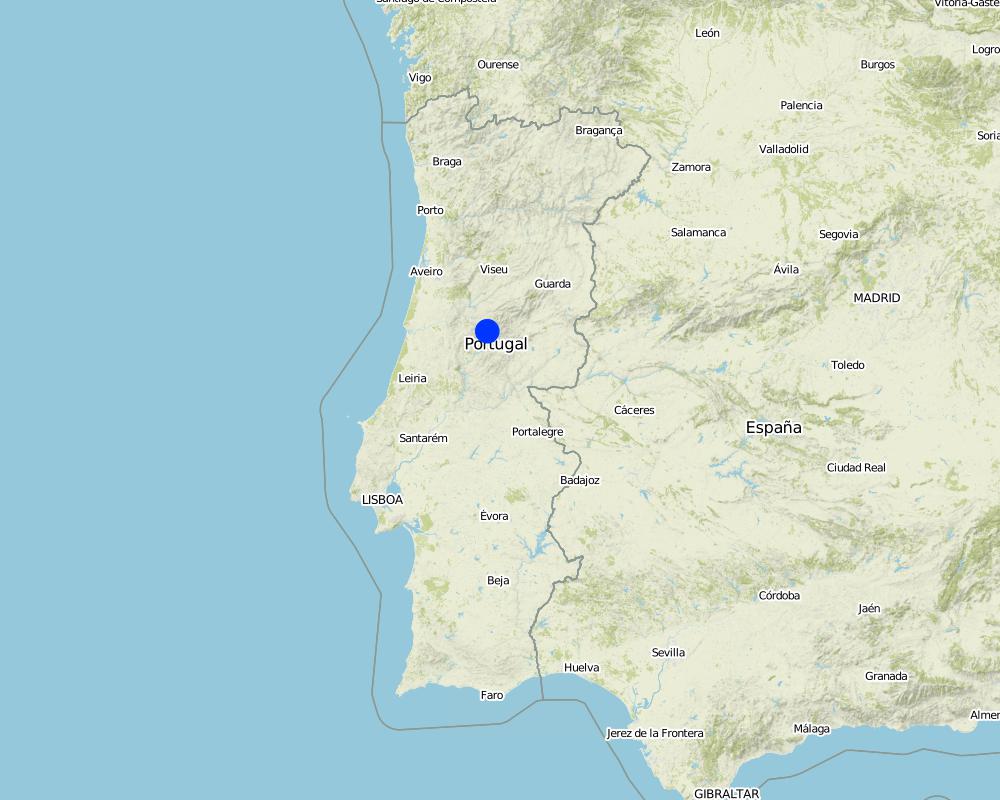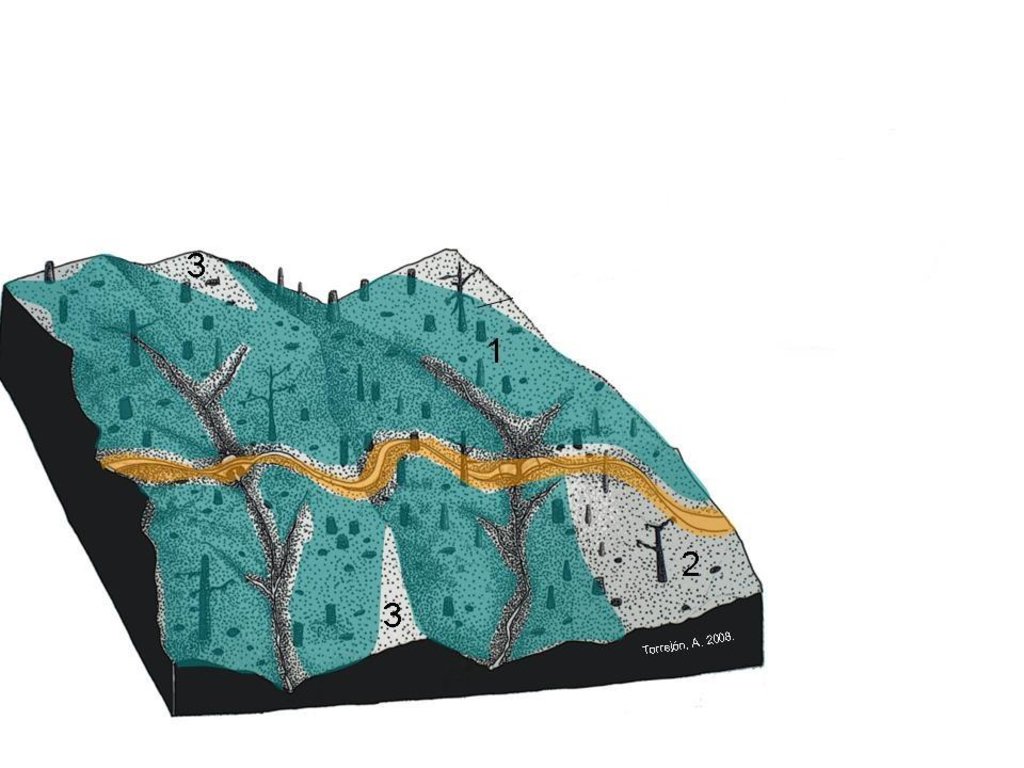Hydromulching for reducing runoff and soil erosion [Portugal]
- Création :
- Mise à jour :
- Compilateur : Sergio Prats Alegre Prats
- Rédacteur : –
- Examinateurs : Valentin Zuercher, Fabian Ottiger, Alexandra Gavilano
Hydromulch
technologies_1299 - Portugal
Voir les sections
Développer tout Réduire tout1. Informations générales
1.2 Coordonnées des personnes-ressources et des institutions impliquées dans l'évaluation et la documentation de la Technologie
Spécialiste GDT:
Spécialiste GDT:
Spécialiste GDT:
Keizer Jan Jacob
Centre for Environmental and Marine Studies (CESAM) - Department of Environment and Planning-University of Aveiro
Portugal
Nom du projet qui a facilité la documentation/ l'évaluation de la Technologie (si pertinent)
Catastrophic shifts in drylands (EU-CASCADE)Nom du projet qui a facilité la documentation/ l'évaluation de la Technologie (si pertinent)
Preventing and Remediating degradation of soils in Europe through Land Care (EU-RECARE )Nom du ou des institutions qui ont facilité la documentation/ l'évaluation de la Technologie (si pertinent)
Fundação para a Ciência e a Tecnologia (FCT) - PortugalNom du ou des institutions qui ont facilité la documentation/ l'évaluation de la Technologie (si pertinent)
University of Aveiro (University of Aveiro) - Portugal1.3 Conditions relatives à l'utilisation par WOCAT des données documentées
Le compilateur et la(les) personne(s) ressource(s) acceptent les conditions relatives à l'utilisation par WOCAT des données documentées:
Oui
2. Description de la Technologie de GDT
2.1 Courte description de la Technologie
Définition de la Technologie:
Hydromulch is spread immediately after a wildfire in order to reduce overland flow and prevent soil erosion.
2.2 Description détaillée de la Technologie
Description:
The research team of the University of Aveiro in collaboration with the fire Brigade and a private company applied the hydromulch in a burnt pine area burnt at moderate fire severity. Hydromulch was spreaded manually from a jet hose over a group of erosion plots, and both runoff and erosion were compared to an untreated group of plots.
The hydromulch was applied at a ratio of 3.5 Mg ha-1 providing an initial ground cover of 80%, and was found to reduce post-fire runoff in 70% and soil erosion in 83%.
Purpose of the Technology: Hydromulch has been particularly useful on steep slopes and strongly modified areas such as quarries, construction sites, and cut and fill slopes along roads (Robichaud et al., 2010). The hydromulch is a complex mixture which contain basically water and wood or paper fibers. Additionally it can contain seeds, surfactants, seed-growing biostimulants, nutrients and a green colorant. It is intended that each component affected some of the pieces of the post-fire runoff erosion process.
The high effectiveness in runoff reduction could be related to the effect of the wood fibers, because it increases the surface water storage capacity, but also due to the effect of the surfactants, a wetting agent that reduces SWR and increases soil infiltration. Ideally, post-fire hydromulching must be carried out immediately after the fire, over bare, unprotected and steep burnt areas. It is intended for places in which burnt severity was moderate to high and where there are very important values at risk, such as water reservoirs, populations, industries, human and wild life.
Establishment / maintenance activities and inputs: The hydromulch is applied once, immediately after the wildfire, aerially, from a tractor or also manually by using a jet hose operated by a person on foot. It basically consisted of a mixture of water, wood fibers and seeds. The seed composition should include autoctonous plant species, in order to avoid alien species into the burnt area and increase the germination success. Besides the composition, the application technique can influence the hydromulch effectiveness. Rough (2007) and Robichaud et al. (2010) reported that the hydromulch sprayed from vehicles was intercepted by the standing trees, and they recommended special caution when applying the mixture in areas with a high density of dead trees and from long distances. Aerial hydromulch can be a better and less expensive option, but Hubbert et al. (2012) checked that the intended application rates of 50% and 100% hydromulch cover resulted in only 20–26% and 56%.
Natural / human environment: The natural forest in central Portugal has been substituted by pine and eucalypt trees that are typically planted as monocultures for wood and paper pulp production. The landscape reflects a long history of intense land management, with a mosaic of (semi-) natural and man-made agricultural and afforested lands. In recent years, however, wildfires have increased dramatically in frequency and extent, and have been associated to soil fertility losses, and consequently to socio-economic losses.
2.3 Photos de la Technologie
2.5 Pays/ région/ lieux où la Technologie a été appliquée et qui sont couverts par cette évaluation
Pays:
Portugal
Région/ Etat/ Province:
Portugal
Autres spécifications du lieu:
Gois-Colmeal
Spécifiez la diffusion de la Technologie:
- répartie uniformément sur une zone
S'il n'existe pas d'informations exactes sur la superficie, indiquez les limites approximatives de la zone couverte:
- < 0,1 km2 (10 ha)
Commentaires:
Plot experiments
Map
×2.6 Date de mise en œuvre de la Technologie
Si l'année précise est inconnue, indiquez la date approximative: :
- il y a entre 10-50 ans
2.7 Introduction de la Technologie
Spécifiez comment la Technologie a été introduite: :
- au cours d'expérimentations / de recherches
Commentaires (type de projet, etc.) :
Hydromulch has been particularly useful on steep slopes and strongly modified areas such as quarries, construction sites, and cut and fill slopes along roads (Emanual, 1976; Benik et al., 2003; Robichaud et al., 2010).
3. Classification de la Technologie de GDT
3.2 Type(s) actuel(s) d'utilisation des terres, là où la Technologie est appliquée

Forêts/ bois
- Plantations d'arbres, boisements
Produits et services:
- Bois d'œuvre (de construction)
- Bois de chauffage
Commentaires:
Major land use problems (compiler’s opinion): Increased runoff and soil erosion, resulting in a decrease of on-site fertility and derived off-site effects such as loss of water quality, reservoirs water volume storage, higher risk of flooding and human beings damage.
Major land use problems (land users’ perception): Loss of wood resources and productivity.
Plantation forestry: Yes
Forest products and services: timber, fuelwood
Constraints of infrastructure network (roads, railways, pipe lines, power lines): price
Number of growing seasons per year: 1
Longest growing period in days: 270Longest growing period from month to month: September to May
3.5 Groupe de GDT auquel appartient la Technologie
- Amélioration de la couverture végétale/ du sol
3.6 Mesures de GDT constituant la Technologie

pratiques agronomiques
- A3: Traitement de la couche superficielle du sol
Commentaires:
Main measures: agronomic measures
Type of agronomic measures: mulching
3.7 Principaux types de dégradation des terres traités par la Technologie

érosion hydrique des sols
- Wt: perte de la couche superficielle des sols (couche arable)/ érosion de surface
- Wg: ravinement/ érosion en ravines
- Wo: effets hors-site de la dégradation

dégradation physique des sols
- Pk: scellage et encroûtement
Commentaires:
Main type of degradation addressed: Wt: loss of topsoil / surface erosion
Secondary types of degradation addressed: Wg: gully erosion / gullying, Wo: offsite degradation effects, Pk: sealing and crusting
Main causes of degradation: deforestation / removal of natural vegetation (incl. forest fires) (Monoculture of forest plantations prone to forest fires)
3.8 Prévention, réduction de la dégradation ou réhabilitation des terres dégradées
Spécifiez l'objectif de la Technologie au regard de la dégradation des terres:
- réduire la dégradation des terres
Commentaires:
Main goals: mitigation / reduction of land degradation
4. Spécifications techniques, activités, intrants et coûts de mise en œuvre
4.1 Dessin technique de la Technologie
Spécifications techniques (associées au dessin technique):
Hydromulch should be spread as homogeneous as possible over steep areas (higher than 15º) burnt at high fire severity (represented in green and 1). Other areas which are flat (2) and burnt at low severity or only partially burnt (3) must be avoided.
Technical knowledge required for field staff / advisors: moderate
Technical knowledge required for land users: high
Main technical functions: control of raindrop splash, control of dispersed runoff: impede / retard, control of concentrated runoff: impede / retard, improvement of ground cover, increase in nutrient availability (supply, recycling,…), sediment retention / trapping, sediment harvesting
Secondary technical functions: control of dispersed runoff: retain / trap, control of concentrated runoff: retain / trap, increase of surface roughness, improvement of surface structure (crusting, sealing), increase of infiltration, increase / maintain water stored in soil
Mulching
Material/ species: water-based mixture of organic fibers and green colorant
Quantity/ density: 3.5Mg ha-1
Remarks: achieve a ground cover of 80%
4.2 Informations générales sur le calcul des intrants et des coûts
autre/ monnaie nationale (précisez):
euros
Indiquez le taux de change des USD en devise locale, le cas échéant (p.ex. 1 USD = 79.9 réal brésilien): 1 USD = :
0,78
Indiquez le coût salarial moyen de la main d'œuvre par jour:
64.50
4.3 Activités de mise en place/ d'établissement
| Activité | Calendrier des activités (saisonnier) | |
|---|---|---|
| 1. | Apply hydromulch | |
| 2. | Trasportation (Track with a jet-spreading system) | |
| 3. | Other |
4.4 Coûts et intrants nécessaires à la mise en place
| Spécifiez les intrants | Unité | Quantité | Coûts par unité | Coût total par intrant | % des coût supporté par les exploitants des terres | |
|---|---|---|---|---|---|---|
| Main d'œuvre | Labour | ha | 1,0 | 128,2 | 128,2 | 100,0 |
| Equipements | Machine use | ha | 1,0 | 128,2 | 128,2 | 100,0 |
| Autre | Hydromulch | ha | 1,0 | 3205,0 | 3205,0 | 100,0 |
| Autre | Others | ha | 1,0 | 128,2 | 128,2 | 100,0 |
| Coût total de mise en place de la Technologie | 3589,6 | |||||
| Coût total de mise en place de la Technologie en dollars américains (USD) | 4602,05 | |||||
Commentaires:
Duration of establishment phase: 0.1 month(s)
Lifespan of the hydromulch: 1 year
4.6 Coûts et intrants nécessaires aux activités d'entretien/ récurrentes (par an)
Commentaires:
The prices were determined in winter 2009 for central Portugal. In other regions and for other formulations these prices can vary. When compared with straw mulch its price is extremely high, but despite this greater expense, hydromulching has been used especially in the USA after some fires when access was difficult, the slopes were too steep or subject to wind to use straw mulch and when there were particularly important ‘values at risk’, such as water reservoirs, cultural or natural heritage sites, national or regional wildlife protected areas or industrial plants
4.7 Facteurs les plus importants affectant les coûts
Décrivez les facteurs les plus importants affectant les coûts :
Accessibility and steepness will raise the costs, but selecting hydromulchings is also a main factor. The more complex the hydromulch the more expensive the application cost. Hydromulch with seeds have also the possibility of introducing invasive plants into the ecosystems and increase the costs. For large and inaccessible areas the aerial hydromulch can reduce the costs.
5. Environnement naturel et humain
5.1 Climat
Précipitations annuelles
- < 250 mm
- 251-500 mm
- 501-750 mm
- 751-1000 mm
- 1001-1500 mm
- 1501-2000 mm
- 2001-3000 mm
- 3001-4000 mm
- > 4000 mm
Zone agro-climatique
- subhumide
Thermal climate class: temperate
5.2 Topographie
Pentes moyennes:
- plat (0-2 %)
- faible (3-5%)
- modéré (6-10%)
- onduleux (11-15%)
- vallonné (16-30%)
- raide (31-60%)
- très raide (>60%)
Reliefs:
- plateaux/ plaines
- crêtes
- flancs/ pentes de montagne
- flancs/ pentes de colline
- piémonts/ glacis (bas de pente)
- fonds de vallée/bas-fonds
Zones altitudinales:
- 0-100 m
- 101-500 m
- 501-1000 m
- 1001-1500 m
- 1501-2000 m
- 2001-2500 m
- 2501-3000 m
- 3001-4000 m
- > 4000 m
5.3 Sols
Profondeur moyenne du sol:
- très superficiel (0-20 cm)
- superficiel (21-50 cm)
- modérément profond (51-80 cm)
- profond (81-120 cm)
- très profond (>120 cm)
Texture du sol (de la couche arable):
- moyen (limoneux)
Matière organique de la couche arable:
- abondant (>3%)
Si disponible, joignez une description complète du sol ou précisez les informations disponibles, par ex., type de sol, pH/ acidité du sol, capacité d'échange cationique, azote, salinité, etc.
Soil texture is medium (sandy-loam)
Soil fertilits is high
Topsoil organic matter is high (forest soil)
Soil drainage/infiltration is poor-medium
Soil water storage capacity is low
5.4 Disponibilité et qualité de l'eau
Profondeur estimée de l’eau dans le sol:
5-50 m
Disponibilité de l’eau de surface:
moyenne
Qualité de l’eau (non traitée):
uniquement pour usage agricole (irrigation)
Commentaires et précisions supplémentaires sur la qualité et la quantité d'eau:
Water quality (untreated) is for agriculutral use only (surface water)
5.5 Biodiversité
Diversité des espèces:
- faible
Commentaires et précisions supplémentaires sur la biodiversité:
Forest plantation
5.6 Caractéristiques des exploitants des terres appliquant la Technologie
Orientation du système de production:
- exploitation mixte (de subsistance/ commerciale)
- commercial/ de marché
Revenus hors exploitation:
- > 50% de tous les revenus
Niveau relatif de richesse:
- pauvre
- moyen
Individus ou groupes:
- employé (entreprise, gouvernement)
Indiquez toute autre caractéristique pertinente des exploitants des terres:
Population density: < 10 persons/km2
Annual population growth: < 0.5%
40% of the land users are average wealthy.
60% of the land users are poor.
Market orientation of production system: subsistence (self-supply), mixed (subsistence/ commercial, commercial/ market
5.7 Superficie moyenne des terres utilisées par les exploitants des terres appliquant la Technologie
- < 0,5 ha
- 0,5-1 ha
- 1-2 ha
- 2-5 ha
- 5-15 ha
- 15-50 ha
- 50-100 ha
- 100-500 ha
- 500-1 000 ha
- 1 000-10 000 ha
- > 10 000 ha
Cette superficie est-elle considérée comme de petite, moyenne ou grande dimension (en se référant au contexte local)?
- grande dimension
Commentaires:
Average area of land owned or leased by land users applying the Technology: 2-5 ha, 5-15 ha, 15-50 ha
5.8 Propriété foncière, droits d’utilisation des terres et de l'eau
Propriété foncière:
- individu, sans titre de propriété
5.9 Accès aux services et aux infrastructures
santé:
- pauvre
- modéré
- bonne
éducation:
- pauvre
- modéré
- bonne
assistance technique:
- pauvre
- modéré
- bonne
emploi (par ex. hors exploitation):
- pauvre
- modéré
- bonne
marchés:
- pauvre
- modéré
- bonne
énergie:
- pauvre
- modéré
- bonne
routes et transports:
- pauvre
- modéré
- bonne
eau potable et assainissement:
- pauvre
- modéré
- bonne
services financiers:
- pauvre
- modéré
- bonne
6. Impacts et conclusions
6.1 Impacts sur site que la Technologie a montrés
Impacts socio-économiques
Production
production de bois
Disponibilité et qualité de l'eau
disponibilité de l'eau pour l'élevage
Impacts socioculturels
connaissances sur la GDT/ dégradation des terres
Improved livelihoods and human well-being
Commentaires/ spécifiez:
Livelihoods and human well-being (eg education, health) are not changed by the use of Hydromulching.
Impacts écologiques
Cycle de l'eau/ ruissellement
quantité d'eau
ruissellement de surface
nappes phréatiques/ aquifères
évaporation
Sols
humidité du sol
couverture du sol
perte en sol
encroûtement/ battance du sol
Biodiversité: végétale, animale
espèces étrangères envahissantes
Commentaires/ spécifiez:
If hydromulching is with seeds, it can introduce invasive species
6.2 Impacts hors site que la Technologie a montrés
inondations en aval
dommages sur les champs voisins
dommages sur les infrastructures publiques/ privées
6.3 Exposition et sensibilité de la Technologie aux changements progressifs et aux évènements extrêmes/catastrophes liés au climat (telles que perçues par les exploitants des terres)
Changements climatiques progressifs
Changements climatiques progressifs
| Saison | Augmentation ou diminution | Comment la Technologie fait-elle face à cela? | |
|---|---|---|---|
| températures annuelles | augmente | bien |
Extrêmes climatiques (catastrophes)
Catastrophes météorologiques
| Comment la Technologie fait-elle face à cela? | |
|---|---|
| pluie torrentielle locale | bien |
| tempête de vent locale | bien |
Catastrophes climatiques
| Comment la Technologie fait-elle face à cela? | |
|---|---|
| sécheresse | bien |
Catastrophes hydrologiques
| Comment la Technologie fait-elle face à cela? | |
|---|---|
| inondation générale (rivière) | pas connu |
Autres conséquences liées au climat
Autres conséquences liées au climat
| Comment la Technologie fait-elle face à cela? | |
|---|---|
| réduction de la période de croissance | bien |
6.4 Analyse coûts-bénéfices
Quels sont les bénéfices comparativement aux coûts de mise en place (du point de vue des exploitants des terres)?
Rentabilité à court terme:
négative
Rentabilité à long terme:
neutre / équilibrée
Quels sont les bénéfices comparativement aux coûts d'entretien récurrents (du point de vue des exploitants des terres)?
Rentabilité à court terme:
positive
Rentabilité à long terme:
très positive
Commentaires:
Hydromulch is seen as a very expensive treatment without clear advantages at the short term, but good at the long term period.
6.5 Adoption de la Technologie
Commentaires:
Comments on spontaneous adoption: The technology has not been applied by any land user. It is a newly research-developed technology.
There is no trend towards spontaneous adoption of the Technology
Comments on adoption trend: The owners are not aware because of the costs, but they will change if the government start funding it.
6.7 Points forts/ avantages/ possibilités de la Technologie
| Points forts/ avantages/ possibilités du point de vue de l'exploitant des terres |
|---|
|
It will prevent sediment movement and accumulation over roads and down slope properties and values at risk. How can they be sustained / enhanced? By developing more economic application formulations and schemes. |
| Points forts/ avantages/ possibilités du point de vue du compilateur ou d'une autre personne ressource clé |
|---|
|
It is a technology that has the advantages of the mulching technique and also can be used as a tool for increase the biodiversity, expand the distribution of some protected plant species at the same time that soil is keep in place. How can they be sustained / enhanced? The use of longer mulch fibers can still increase the hydromulch effectiveness, since some researchers found the longest fibers to be more effective in soil erosion control than the shorter ones. |
6.8 Faiblesses/ inconvénients/ risques de la Technologie et moyens de les surmonter
| Faiblesses/ inconvénients/ risques du point de vue du compilateur ou d'une autre personne ressource clé | Comment peuvent-ils être surmontés? |
|---|---|
| Hydromulch is very expensive when compared to straw mulch, but not more effective in post-fire soil erosion reduction. | To develop hydromulch mixtures using the lowest amount of water as well as other chemical components to the minimum. |
| Some researchers found very low performance due to the interception of the hydromulch jet by the dead standing trees | Verify when applying it that the ground coverreach a minimum of 60% |
| Sometimes the mulch component (wood fibers, chopped paper) can be removed very easily by heavy rainfall, and thus treatment effectiveness can decrease greatly. |
7. Références et liens
7.1 Méthodes/ sources d'information
7.2 Références des publications disponibles
Titre, auteur, année, ISBN:
EFFECTIVENESS OF HYDROMULCHING TO REDUCE RUNOFF AND EROSIONIN A RECENTLY BURNT PINE PLANTATION IN CENTRAL PORTUGAL. Prats et al. (in press). Land Degradation and Development DOI: 10.1002/ldr.22362-Effects of hydromulch on post-fire erosion and plant recovery in chaparral shrublands ofsouthern California. Hubbert et al. 2012 International Journal of Wildland Fire 21:155–167.Rough D. 2007. Effectiveness of rehabilitation treatments in reducing postfireerosion after the Hayman and Schoonover fires, Colorado FrontRange. Fort Collins, CO: Colorado State University. MsC. Thesis; 186.Robichaud PR, Ashmun LE, Sims BD. 2010. Post-fire treatment effectivenessfor hillslope stabilization. General Technical Report, RMRS-GTR-240. U.S. Department of Agriculture, Forest Service, Rocky Mountain ResearchStation, Fort Collins, CO.
Liens et modules
Développer tout Réduire toutLiens
Aucun lien
Modules
Aucun module trouvé


